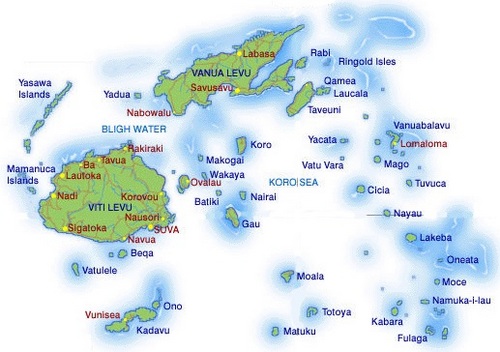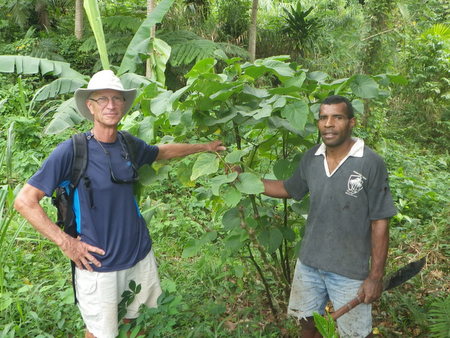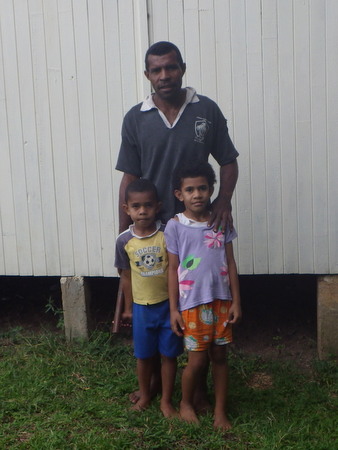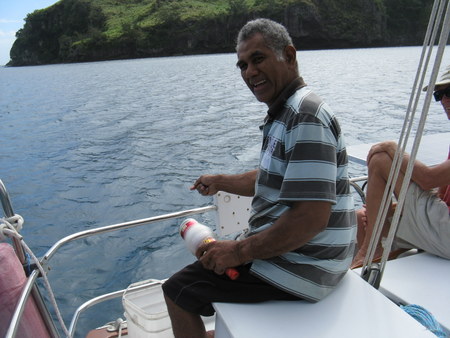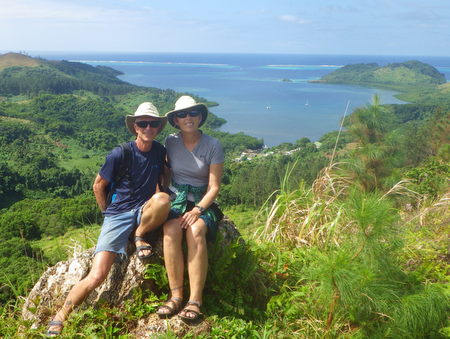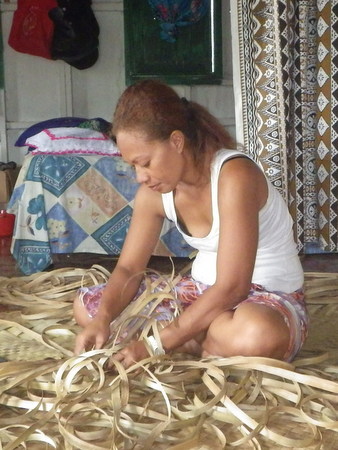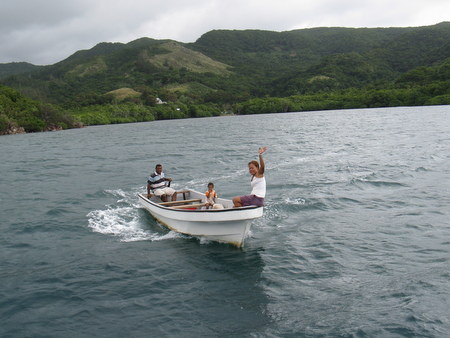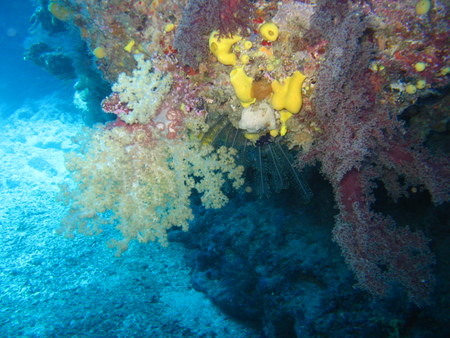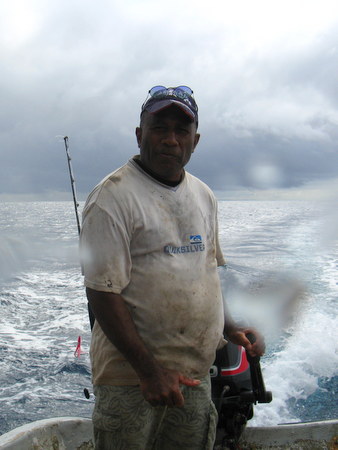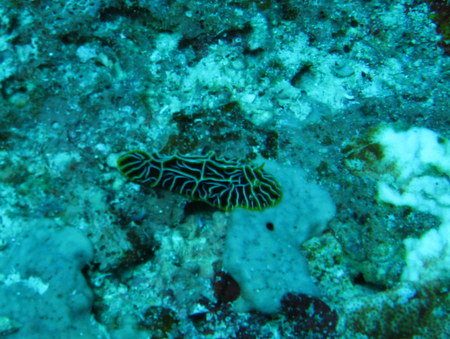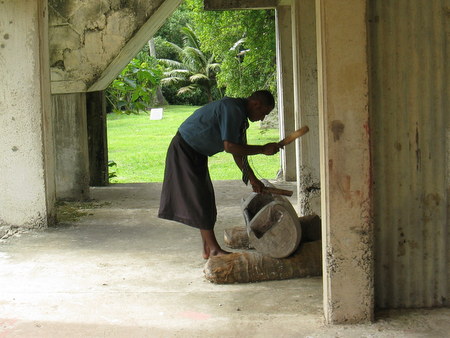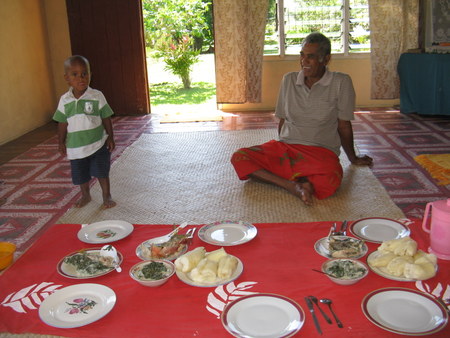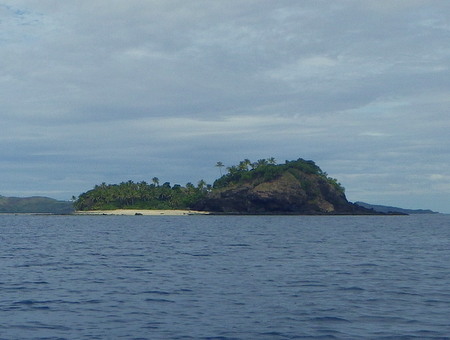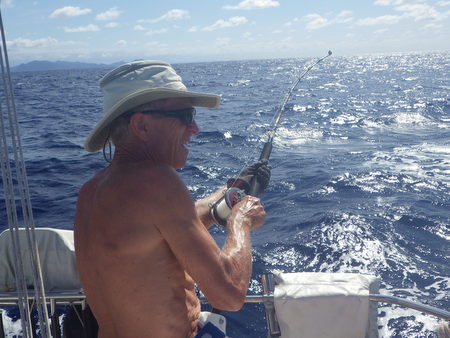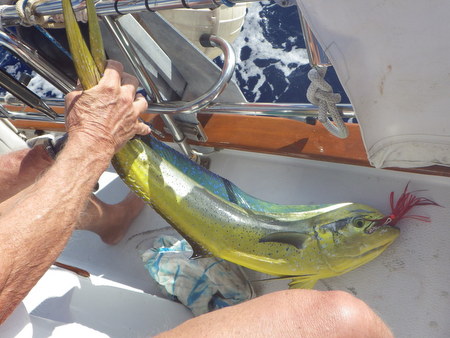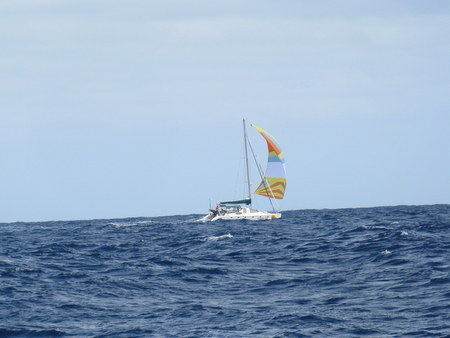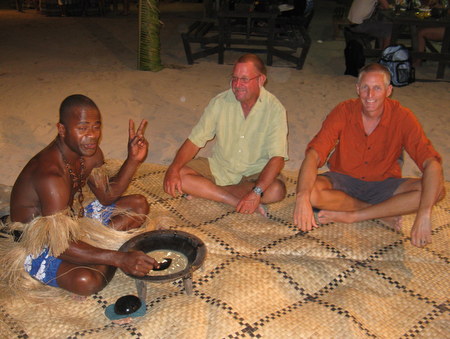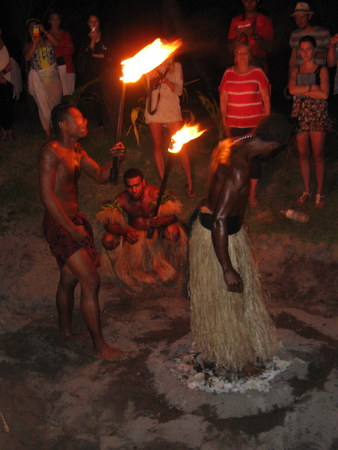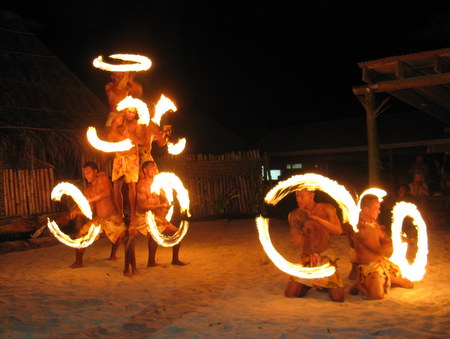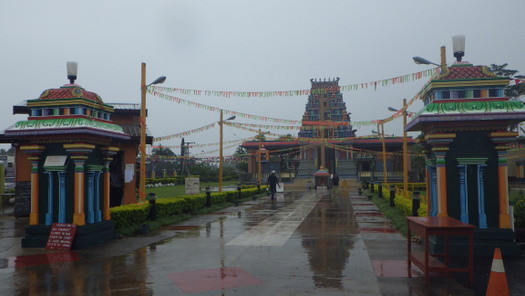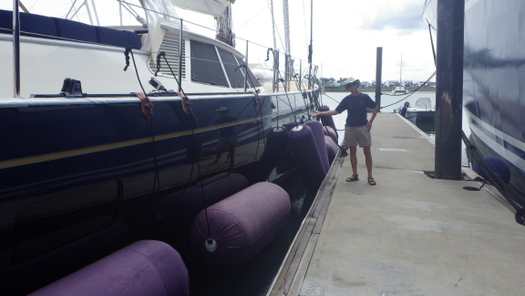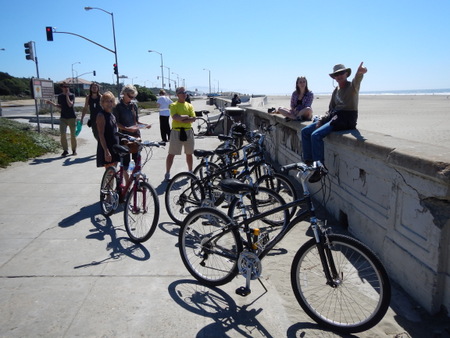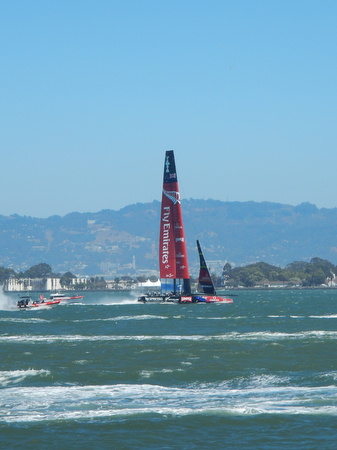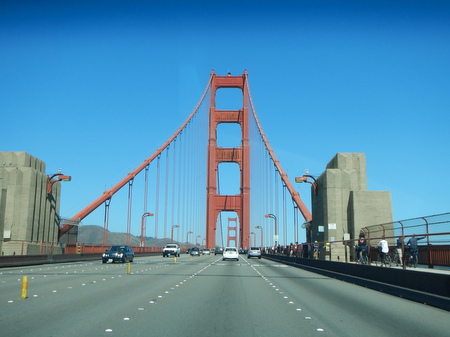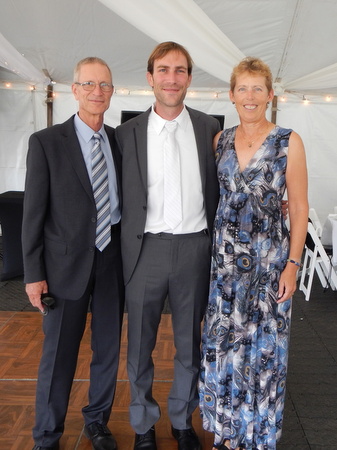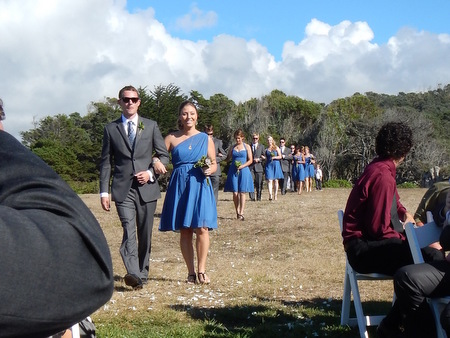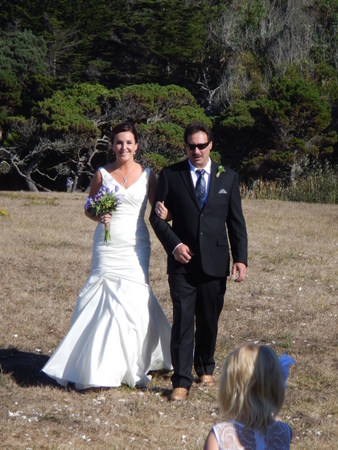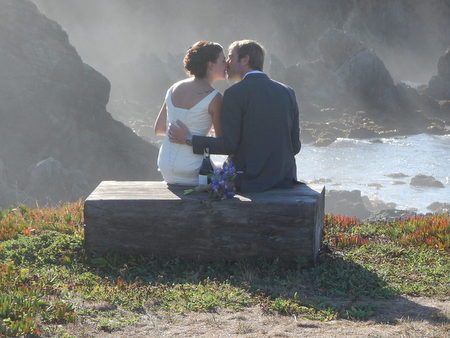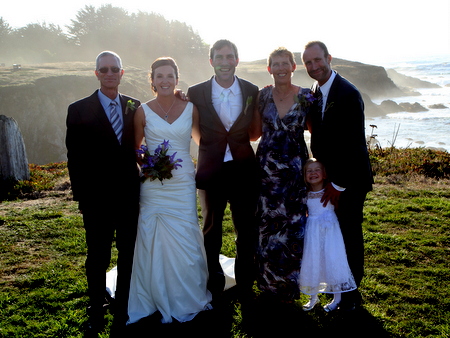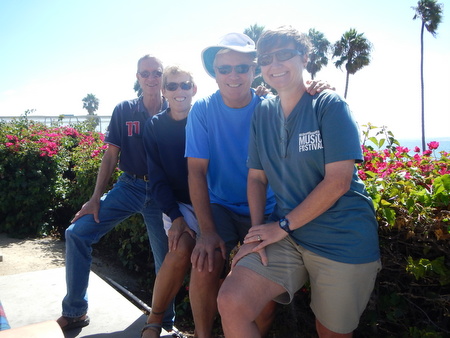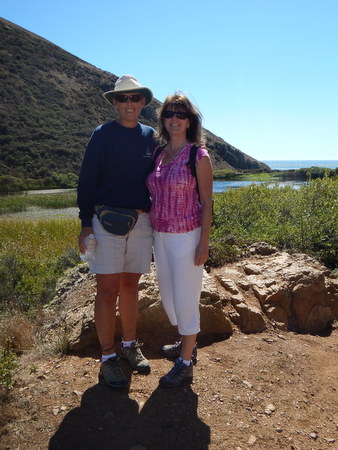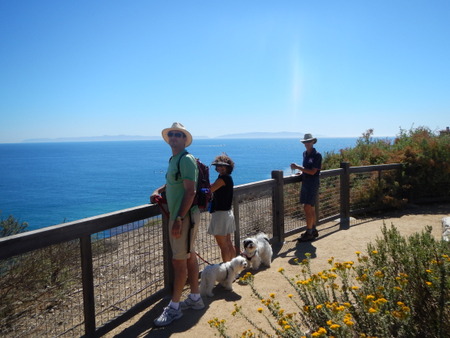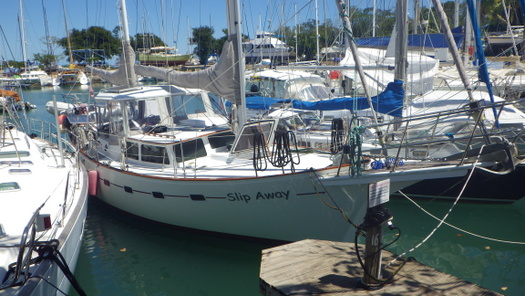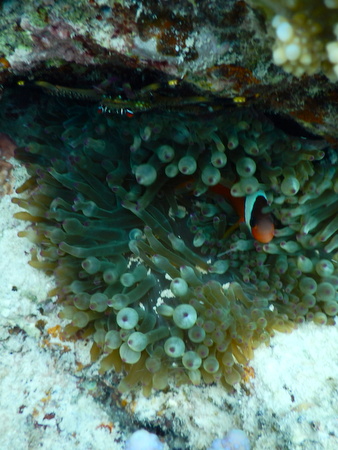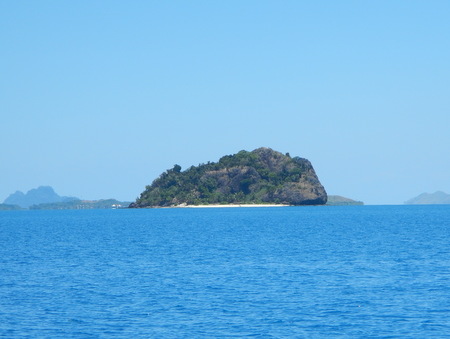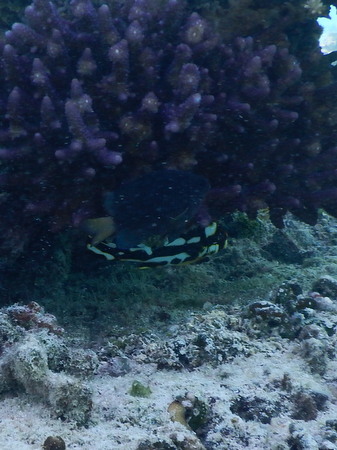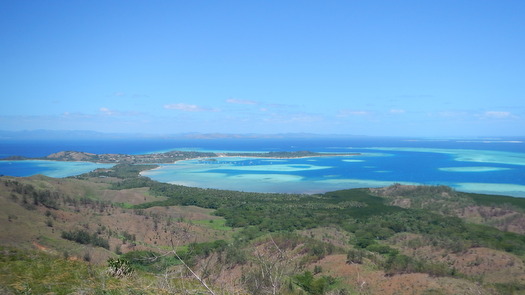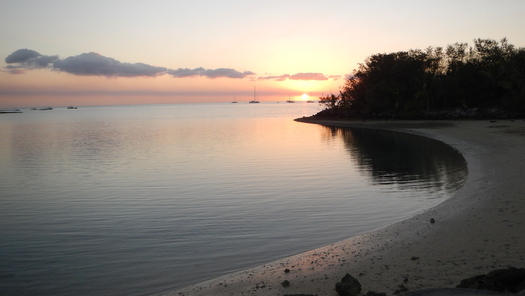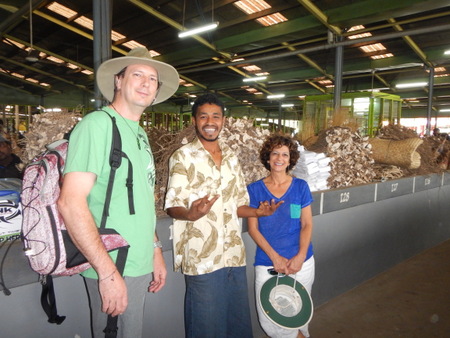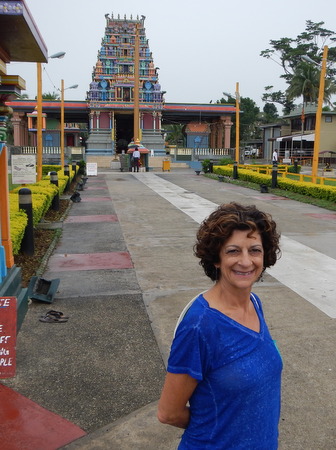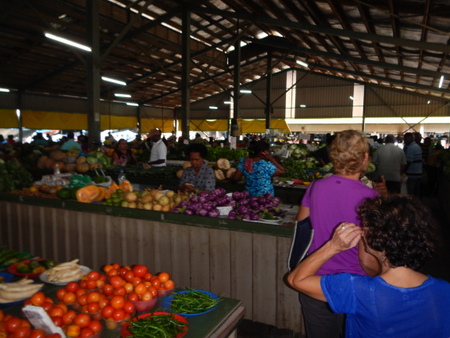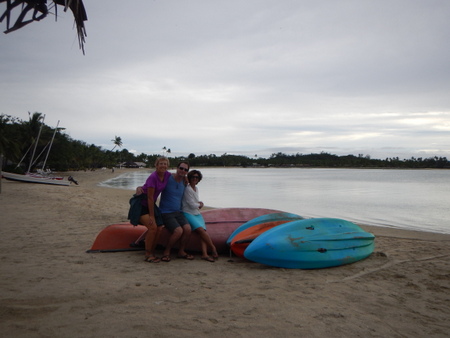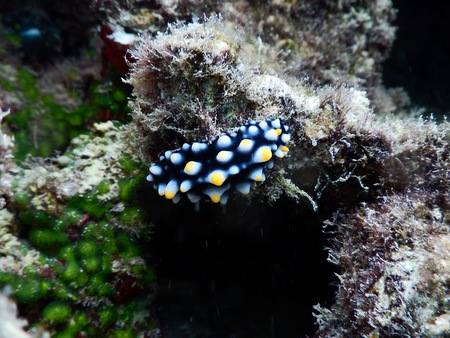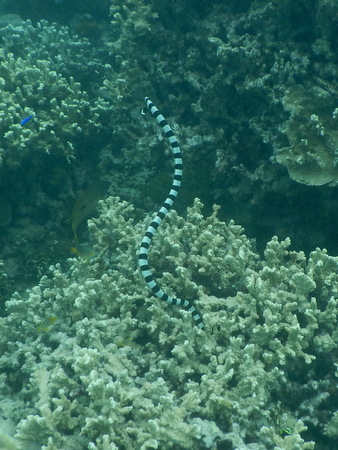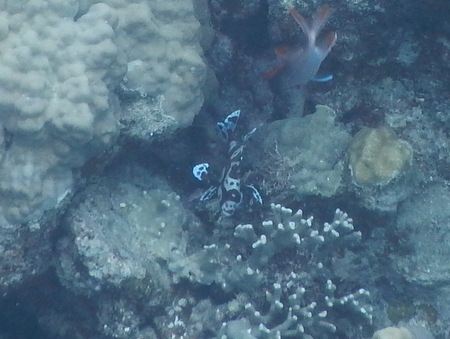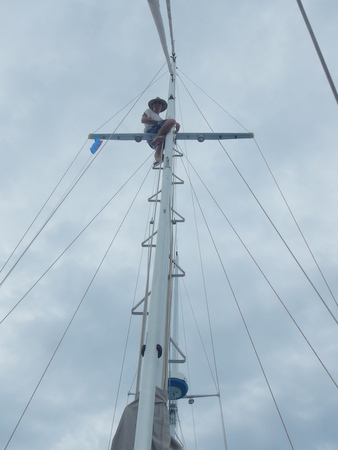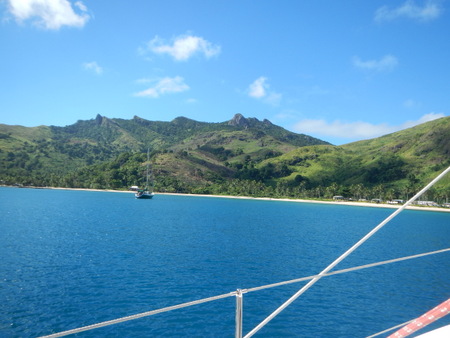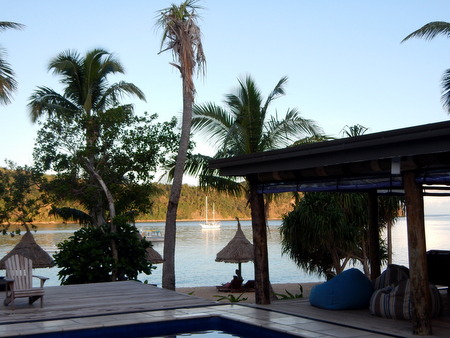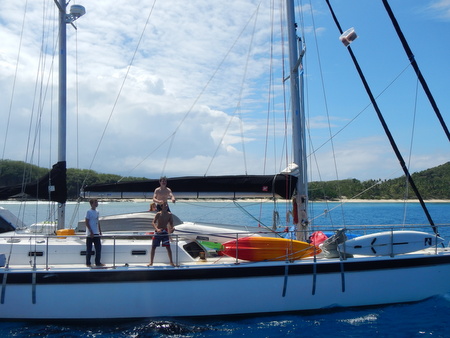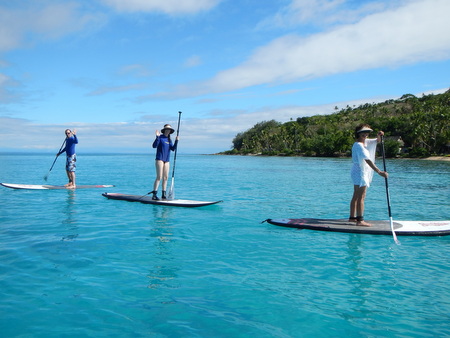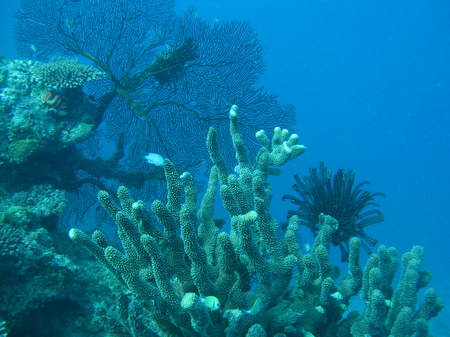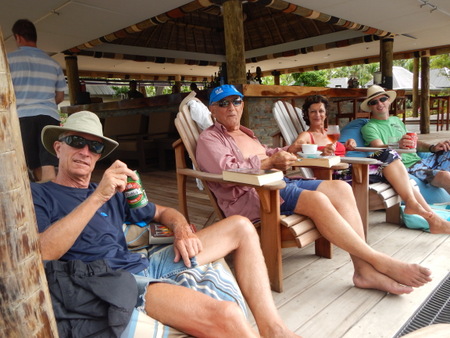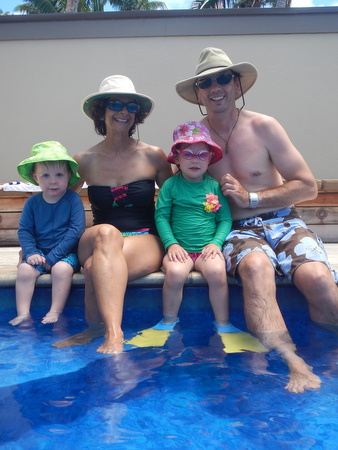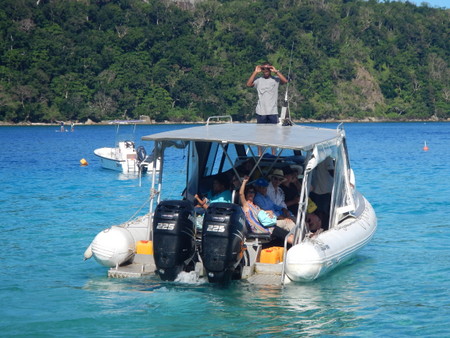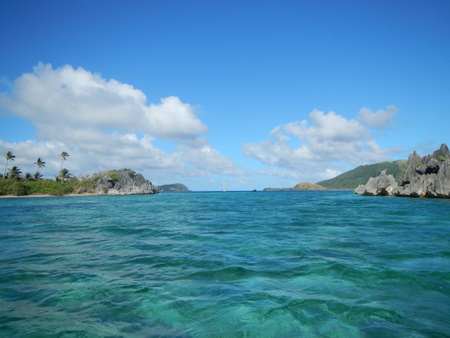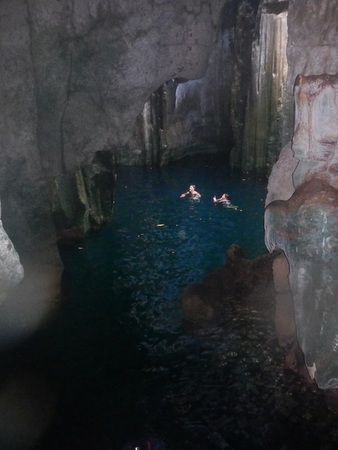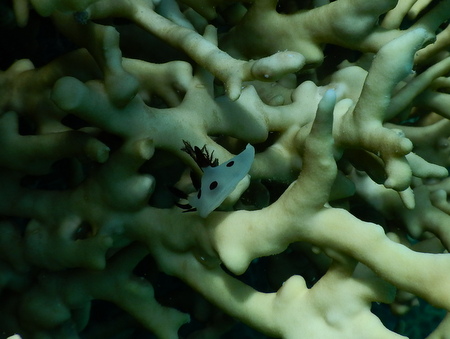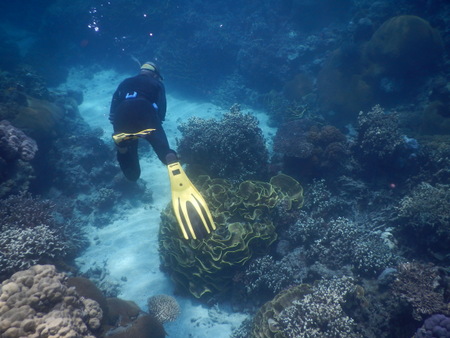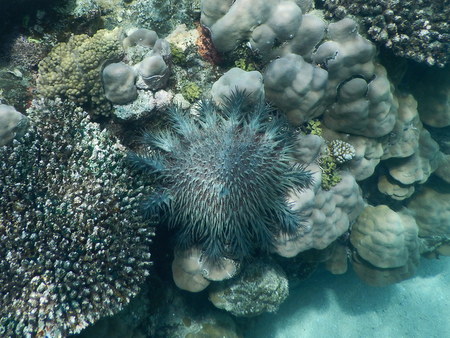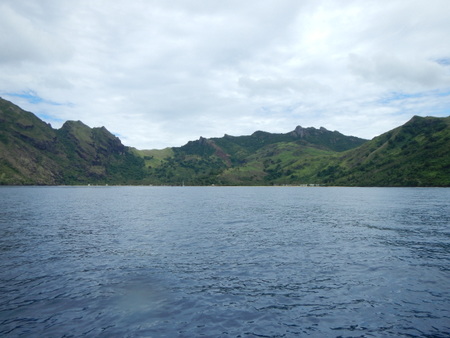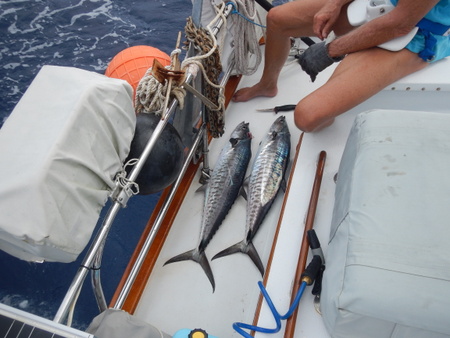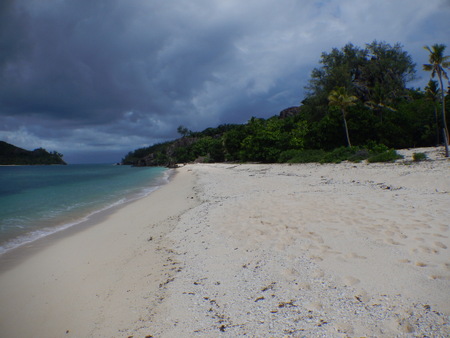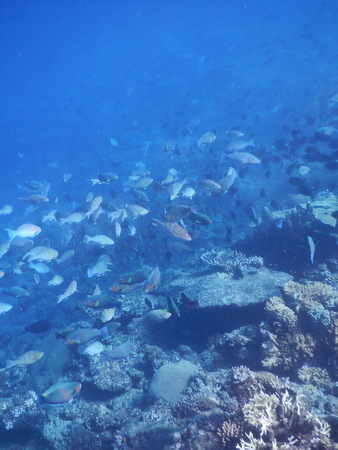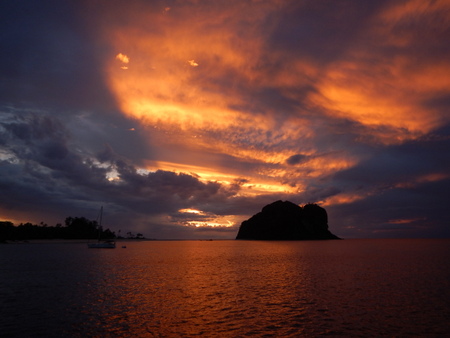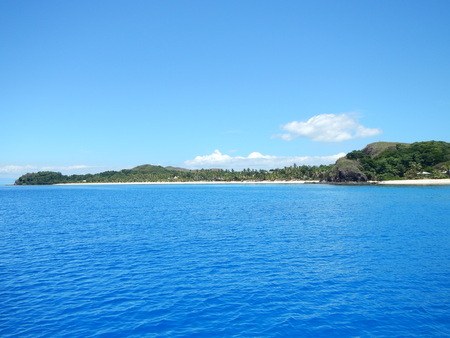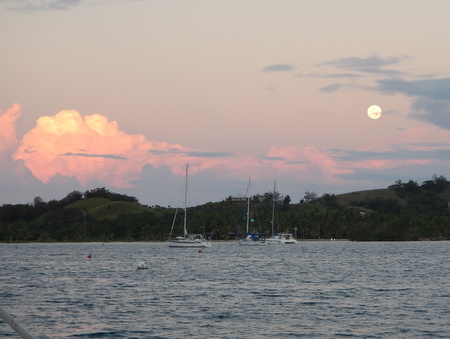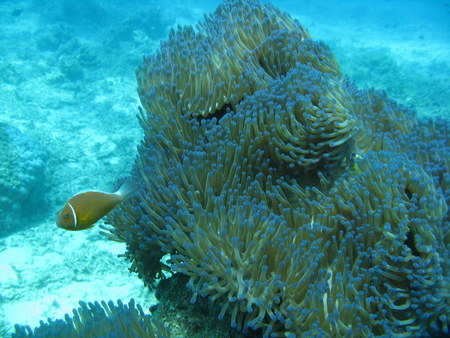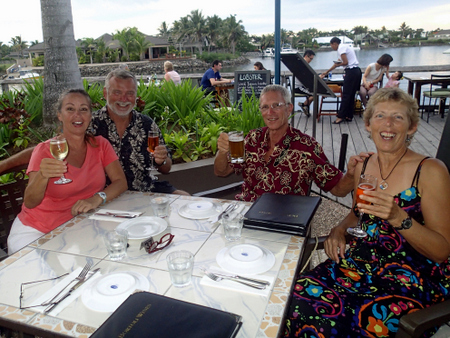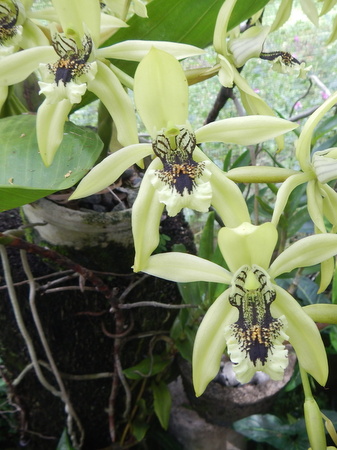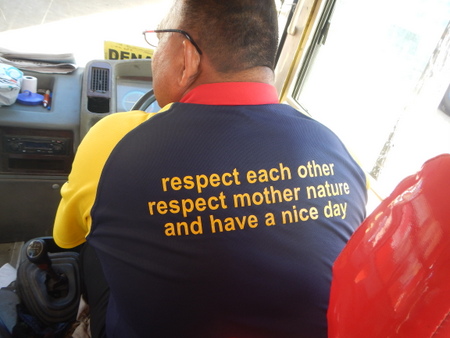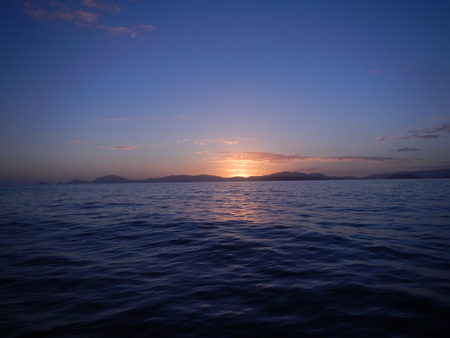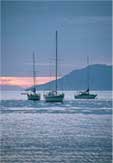
Logbook: Fiji Part Two - Ono & Kadavu, Viti Levu (South and West Coasts), Mamanucas & Yasawas (August to November 2013)
+ Erik & Chrissy's Wedding in Fort Bragg, CA (September 2013)
After spending our first couple of months in Fiji exploring the more traditional islands in the east, we sailed to Kadavu, which is Fiji's third largest island. Kadavu and the neighboring smaller island of Ono are located about 40 miles south of Viti Levu, which is Fiji's largest and main island. We spent a few weeks in Ono and Kadavu before sailing along the southern coast of Viti Levu and making our way to western Fiji, which is the more developed and touristy area. In September, we took a short break and flew back to California for a very special wedding - Rich's son Erik and his bride Chrissy. In October, we had visitors for a couple of weeks, and then in November, we wrapped up our cruise of Fiji. On December 1, we set sail back to New Zealand. For a bit more detail on these past few months, read on...
Passage from Viani Bay, Vanua Levu to Nabouwalu Bay, Ono Island (August 6-7, 26 ½ hours, 160 nm). Our course from Viani Bay in northeast Fiji to the islands of Ono & Kadavu was just slightly west of south, so we waited and watched for a forecast of easterly winds, instead of the prevailing southeast trades, to make it a more pleasant sail. When we left Viani Bay, we were in the lee of Taveuni, and we had little wind and calm seas. Two hours later, we had 18-20 knots of wind from the east, and we were sailing along at 6 knots with a reef in the main and our staysail. It was not a particularly pleasant sail with 4 to 6 foot seas on our beam, and the Koro Sea lived up to its reputation as a rough stretch of water. In any event, it was only one day and night of bouncing around, and the next morning, we dropped our anchor at Nabouwalu Bay, on the west side of Ono Island. It was an overcast morning, so we didn’t have good visibility going into Nabouwalu Bay, but we found that the Navionics charts on our iPad (a recent addition to our navigation tools) were quite accurate, and we got in with no issues. When we arrived, we had a hearty breakfast, tidied up the boat, and took a much-needed nap.
Nabouwalu Bay, Ono Island (August 7 to 9). We didn’t make it ashore our first day in Nabouwalu, but the next morning, we headed into the village to do our sevusevu. We met chief Miti, who blessed our kava and welcomed us. After sevusevu, we walked around the village a bit and decided we would stretch our legs on a hike to the village of Nagara – a few miles away via a dirt path. The chief pointed us to the “trailhead”, and as we wandered in that direction, we were met by a local guy named Asa who offered to walk with us. The Fijians are very friendly that way – they want to be sure their visitors are well looked after. It was nice to have Asa show us the way because the path was a bit rugged, and he had a machete to chop down some overgrown areas. Also, there were a couple forks in the path, so we quite possibly could have missed a turn and got lost. (This is just a path that the locals use to travel between villages – no signs!)
We enjoyed the hike with Asa. We walked through some areas where people were growing a few crops, and Asa identified some of the plants for us. When we got to Nagara, he climbed a coconut palm, cut down a few coconuts for us, and opened them with his machete for a refreshing drink of coconut milk. The primary school for the island is in the village of Nagara, and two of Asa’s kids go to school and board there. There is usually one school serving several villages on an island, and the kids board during the week while they attend school. Parents take turns each week preparing meals and watching after the kids. We walked through the schoolyard as school was being let out for the day, and his kids were very excited to see Asa (and vice versa).
When we got back to Nabouwalu, at Chief Miti’s request, we stopped back to say hello to him before we headed back to Slip Away. His wife brought us some lemongrass tea as we sat outside their home and talked with the Chief. He told us that the next day, all the folks from Nabouwalu were walking over to Nagara for a school fundraiser. He was not able to go because he was having some back problems and couldn’t walk that far. So, he wanted to come out and go fishing on Slip Away. He didn’t really ask us if he could come out to fish on Slip Away, he just told us that he wanted to and that we should pick him up at 10 a.m. He wasn’t rude – it was just a reminder to us about differences in cultures. Although we'd been thinking that we wanted to snorkel that next morning, we felt like we couldn't really refuse Chief Miti's request since we were visiting his village and anchored in his bay. We ended up having a very nice day with Chief Miti on board. He was happy to stay anchored in the bay while he fished, but he caught nothing - his fishing luck wasn’t any better that ours of late! He told us a bit more about himself, and we were amazed at some of his life experiences. He served in the Fijian army and was part of a U.N. peacekeeping force in the Middle East.
Rich & Asa with the pepper plant used to make Kava
Asa with his kids at the Nagara School
Chief Miti fishing from Slip AwayAfter a few hours of fishing (but no catching) and lunch on board Slip Away, Chief Miti was ready to home. We ran him to shore in the dinghy, and shortly after returning to Slip Away, we got a call from Craig & Bruce on s.v. Gato Go, who were sailing past our anchorage. Gato Go was headed to Kavala Bay, on the north end of Kadavu Island. The weather forecast was calling for westerly winds by the next morning, not a good wind direction for our present anchorage, so we were eager to move on too, and we weighed anchor and followed Gato Go down to Kavala Bay (7½ miles away).
Kavala Bay (August 9-11). When we got to Kavala Bay, Gato Go invited us over for dinner. Although we didn’t know Craig & Bruce (Jan had met them briefly in the dock in Savusavu, and Rich had never met them), we had lots of friends in common. There was one other boat in the anchorage (a German boat), and Gato Go invited them too. It was an interesting evening. The crew of Gato Go and Slip Away hit it off quite well, but neither of us connected with the German couple, whom we affectionately still refer to as Adolf and Eva.
The weather was rainy and crappy the next day, so we all hunkered down, stayed on board our respective boats and had a low-key day. The weather was much improved the following day with light winds and abundant sunshine, and Slip Away and Gato Go headed out to Matasawalevu Bay on the northeast corner of Kadavu. We kept looking over our shoulders but Adolf and Eva did not follow (sigh of relief!).
Matasawalevu Bay, Kadavu Island (August 11-14). It was a short trip from Kavala Bay to Matasawalevu Bay (9 miles), and we motored in light winds. There is an area between the two bays which is laced with reefs, and the charts are not very accurate, so we were a bit nervous about transiting it. We did our best to plot a course using all of our sources – C-Map charts on the chartplotter, Navionics charts on our iPad, and Google Earth charts on Open CPN, and as we got to the reef infested area, Rich stood out on the bowsprit, while Jan steered the boat, and we talked to one another on our “marriage saver” headsets. The trip through the reef was easier than anticipated, but we still breathed a sigh of relief when we came out the other side.
From Matasawalevu Bay, we were eager to scuba dive the nearby Naigoro Pass, and it appeared that we would have good conditions to do so over the next couple of days. We had tried to contact a local guy named Bruce O’Connor, who had taken a number of our friends diving in the pass a few weeks prior, but our calls and emails to him were unanswered.
The crews of Slip Away and Gato Go did sevusevu in the village, and mentioned to the Tauranga ni Koro (the Chief's representative) that we were interested in scuba diving. We also asked to say hello to a local woman named Pauline, who befriended our friend Sandy (s.v. Gypsea Heart) when she visited this village. When we met Pauline, we also met her husband Mas, who had recently returned from working in Suva. Quite fortuitously, Mas is a divemaster who used to work for a local dive shop, and he had his own long boat and was happy to take us diving in the Naigoro Pass. We worked out a financial arrangement, and made a plan to dive with him the next day.
The Naigoro Pass is a drift dive, so the plan was for Mas to drop us in the water, follow our bubbles and pick us up at the end. Mas speaks English quite well, and he gave us a very good briefing of the area before our dive. He told us that it was spawning season for the potato cod or camouflage grouper, so we could expect to see a lot of them. We did two dives in the pass – the north and south walls – and the dives were outstanding! We saw lots of camouflage grouper – way more than we’ve ever seen before. The other fish life was also good – angelfish, anemonefish, wrasse, triggerfish, dartfish – and the soft corals were beautiful. Too bad we left our camera home that day! In addition to the dive, the two of us did a hike with Pauline to a viewpoint which overlooked the anchorage and pass.
We were hoping to do another dive with Mas, but the southeast tradewinds picked up, making the anchorage uncomfortable, and conditions unfavorable for a dive, so we made plans to leave. Before we left, Mas and Pauline delivered gifts of bananas and taro and hugged us all good-bye. In a few short days, this young couple made us feel very welcome in their village, and we hated to leave. If the weather had remained calm, we would have stayed much longer.
The two of us enjoying the view of Slip Away and Gato Go anchored
in the bay, with the Naigoro reef pass in the background
During our visit, Pauline was busy weaving
pandanus mats for special occasions in the village
Mas, Pauline and their son Noah came out to say good-bye to us.
Nabouwalu Bay, Ono Island (August 14-20). In strong tradewinds, Nabouwalu Bay on the west side of Ono Island was an ideal anchorage. Although we had already spent a couple of days in this anchorage, we were eager to return to do some diving at the nearby Alacrity Rocks, so Gato Go and Slip Away threaded their way back through the reefs and made our way there (11 miles).
When we got back to Nabouwalu Bay, Craig (s.v. Gato Go) inquired ashore to see if we could find another local guy with longboat to take us out diving. Getting to and from the dive sites in a longboat is faster and more comfortable than doing it in our dinghies, and having someone on the surface gave us an added margin of safety. Also, it was nice to offer a local guy an opportunity to make a few extra dollars. We ended up diving with a guy named Isaac here. Like Mas, Isaac had worked in the past for a dive shop, so he knew the locations of the good dive sites (and he didn’t need a GPS to find them!). Isaac’s English wasn’t very good, so we didn’t get a good dive briefing, but he was a super nice guy. We dove with him a couple of times, and he took us to some great spots. Split Rock was our favorite site in this area, and this time we made sure we had a camera with us. The fish life was not as prolific as other places in Fiji, but the corals and rock formations were beautiful. When we went out diving with Isaac, the local minister Steve joined us and fished while we were diving.
The underwater scenery was very colorful at Split Rock
Our divemaster Isaac
We found several small creatures on these dives,
like this Halgerda ReticulidiaWhen Sunday rolled around in Nabouwalu, and since the minister Steve had been out with us on our dive trips, we were invited the church service. Each service we attended in Fiji had its own twist, and the part of the service here that caught our attention was the money collection. In the previous services we attended, a plate was passed around and people made a donation. Here, Asa (the guy who took us on our hike), sat at a small table at the front of the church and did a roll call. When an individual’s name was called, they walked up to the table, gave their donation, and Asa recorded it. After he was done with the roll call, Asa read out each person’s name and told how much they donated. And then they continued on with the service. It was all a bit odd, and we thought attendance at this church seemed a bit low.
After church, Chief Miti and his wife invited us to their house for lunch, and we were served the standard fare of fish, palusami (taro leaves) and taro. As we were putting food on our plates, Chief Miti handed Jan a plate with a piece of fish on it - the head! Yikes!! She must have had a startled look on her face because the chief’s wife smiled and told her that eating the head makes you very smart. So, Jan accepted the head and went to work picking out the small pieces of fish among the bones – and trying not to look at the fish eyes which were staring at her. It was messy work, and she used her napkin frequently to wipe off her fingers, and at one point, she looked down, and her napkin was covered with ants! So, she was delicately trying to shake the ants off the napkin behind her back, while Bruce (s.v. Gato Go) sat next to her giggling. Jan maintained her composure, but she was very happy when that meal was over!
Pastor Steve banging on the "lolly". The sound can be heard throughout
the village and announces that it's time for church.
Ready for lunch at Chief Miti's house
After Sunday lunch, the locals usually nap, so we headed back to our respective boats. When we had arrived for church, the tide was out, so we had anchored our dinghy at the edge of a sandbar. While we were ashore, the tide had come in, so we waded out to the dinghy in water that came mid-way up our shins. The water was very clear, and we saw several sea snakes laying on the bottom. Sea snake bites are very poisonous, but they have very small mouths, so can only bite very small areas – like between your fingers and toes. Eek!! We treaded very carefully back to the dinghy.
Dravuni, Namara and Yaukavelevu Islands (August 20-25). Just north of Ono Island, we wanted to visit a small uninhabited island called Namara, but in order to do that, we needed to present sevusevu on the island of Dravuni since Namara was under their control. So, from Nabouwalu Bay, we motored up to Dravuni Island (9 ½ miles) where we did sevusevu, and then we backtracked a couple of miles to Namara and settled in for a few days of snorkeling and beachcombing. Gato Go went off in another direction for a day, but then joined us there, and we found a flat calm day to take our dinghies out to the Herald Pass for a dive. We spent our last day in this area at Yaukavelevu Island for a change of scenery, but a big resort was being built on that island, so it wasn’t such a peaceful spot, and we were wishing we had stayed at Namara.
We really enjoyed the past few weeks at the Ono/Kadavu Island group, but we needed to get a move on. Erik & Chrissy were getting married in less than a month, so we needed to make our way to Vuda Point Marina on the west coast of Viti Levu where we would leave Slip Away while we traveled to California for the wedding. Craig & Bruce (s.v. Gato Go) were heading in the same general direction, and we were having a great time hanging out with one another, so we continued to travel together. Along the way, we both wanted to stop at Robinson Crusoe Resort in Likuri Harbor. Robinson Crusoe was about 90 miles away – too long for a day sail, and rather than do an overnighter, we broke the trip up into two smaller hops, first to Vunaniu Bay and then on to Likuri Harbor.
Idyllic islets dotted the lagoon just north of OnoPassage from Yaukavelevu Island to Vunaniu Bay, Viti Levu (August 26, 55 nm, 10 hours). The passage to Vunaniu Bay on the south coast of Viti Levu would be a long day sail, so we needed to get an early start - before dawn. Since the departure involved sailing through a break in the reef, we took a spin out the pass the day prior and laid a track on our chartplotter, which we could follow the next morning to get out safely.
We weighed anchor at 5:30 that morning, and 45 minutes later we were safely out the pass. By 7 am, we had the headsail, main and mizzen sails flying, and we were sailing along at 6 knots with 10-12 knots of east-southeast wind (just aft of our starboard beam). By 8:15 a.m., we had landed a nice-sized mahi mahi, and a couple hours later, we landed a second one! Wow! Our fishing luck had finally taken a turn for the better! Prior to this, the only fish we caught was a small one by Namara Island. What a great day – good fishing and a good sail! We pulled into the Vunaniu Bay anchorage and shared some of our catch with Gato Go at dinner.
Rich is smiling as he is reeling in our catch.
One of the mahi mahi we caught that day - good eating!
Passage from Vunaniu Bay to Likuri Harbor/Robinson Crusoe Resort (August 26, 41 nm, 7 hours). We didn’t have quite as far to go on our second day, so we slept in a bit and departed at 7 a.m. Winds were forecast to be light – 8-10 knots from the east – and during dinner the night before, the crews of Slip Away and Gato Go agreed it would be a great day to run our spinnakers. We had no wind when we left the anchorage, but a couple of hours later, the wind came up to 10-12 knots from the east (directly behind us). We hoisted the spinnaker, shut down the engine, and enjoyed the ride. Thirty minutes later, the wind had built to 17 knots, and we took our spinnaker down. When the wind gets over 15 knots, the spinnaker is too much sail for us. Gato Go departed the anchorage behind us, and Jan called them on the radio to tell them we had taken our spinnaker down because the wind was building. They said they were only seeing about 12 knots of wind, so were still under spinnaker. We had unfurled our headsail and were continuing on with just that, and already the wind was up to 20 knots. Shortly afterward, Gato Go went screaming by us at about 10 knots. They realized a bit too late that their wind instruments were reading incorrectly, and when they tried to douse their spinnaker, the dousing sock didn't work properly. They told us later it was quite a challenge getting their spinnaker down, but they eventually succeeded with no major mishap. The winds ended up building up to 20-25 knots with a few gusts up to 30 – slightly different from the weather forecast! We hooked yet another mahi mahi on this passage. We were so stoked – we were using a new lure, and this one was obviously hot! But, as we reeled in this fish and Jan went to gaff it, the line broke, and we lost both the fish and the lucky lure. Dang it!!
Gato Go flying by us under spinnakerLikuri Harbor/Robinson Crusoe Resort (August 27 to 29). When we arrived at Likuri Harbor, we had definitely crossed the line from the more traditional and less touristy areas of Fiji to the less traditional and more touristy. Robinson Crusoe Resort is known for a dinner show that they put on a couple times a week with fire and knife dancers. They bring tourists in from other hotels by bus and boat for the shows, and they are also very welcoming to cruising yachts. When we arrived, we went ashore, and enjoyed a happy hour at the beach bar – we hadn’t seen a beach bar for months! The dinner and dancing show was excellent – high energy and great fun. We really enjoyed it.
Craig & Bruce (s.v. Gato Go) sampling a bit of kava before dinner
Fire walking demonstration - this guy is walking
on the coals which cooked our dinner. Ouch!!
The fire dancing show was very entertaining.Malolo Lailai Island/Musket Cove Resort (August 29 to September 3). From the Robinson Crusoe Resort at Likuri Island, we ventured further into the touristy side of Fiji and sailed to Musket Cove Resort at Malolo Lailai Island. On our passage to Musket Cove, we had a beautiful wing-and-wing sail with 15-20 knots of wind from the stern and gentle seas (22 miles, 4 hours).
Musket Cove is very popular with the cruising community. It has a small marina with berths and mooring balls, room to anchor, a couple of restaurants and bars, laundry, a couple of small grocery stores, pretty beaches and a golf course. The beach bar at Musket Cove has several barbeque grills available, and quite often folks take their dinner ashore and cook it on the “barbie”, while enjoying happy hour. While initially it was a shock to us to see so many boats in one place, we found Musket Cove to be a great place to catch up with friends for a few days.
Port Denarau Marina (September 3 to 6). We were slowly working our way up to the big time. From Musket Cove, we headed to Port Denarau Marina (14½ miles), where we had booked a mooring for a few days so we could get our scuba tanks hydro tested by the local dive shop. Port Denarau is THE most touristy place in Fiji – a marina for big fancy yachts, a Hard Rock Café, and trendy restaurants and clothing shops. Oh boy!
Despite it being the most exclusive marina in Fiji, it’s really not all that expensive, and they have a few moorings for rent at a very reasonable FJD $15 per day (about USD $8). We had booked a mooring several weeks prior, but when we arrived, there was a mix-up with our reservation, and they could not give us our mooring. They offered, however, that they had a berth available, and we could have it for the price of a mooring since it was their error. That sounded kind of nice, so we said OK, and proceeded into the marina to find our berth, which they told us was C-8. While we were waiting for the mix-up to be sorted out, we were anchored outside the marina and should have dinghied in to check out the location of the berth, because we would never have imagined that C-8 was the first berth on the dock, next to the travel-lift and loading dock and with precious little maneuvering room. Getting into the berth was an adventure – thank goodness the folks in the berth next to ours (on s.v. Bamboozle - love that boat name!) were home and popped out to help us tie up. Jan (who usually drives the boat) was immediately worried about how the heck we were going to get out!
We spent three days in Port Denarau, accomplished a few chores and had some fun too. The scuba tanks were picked up, tested, certified and delivered back to us. We ran into a couple of ladies we knew from the Caribbean on the dock (small world!) and enjoyed drinks with them. Gato Go came in a couple of days after us and scored a mooring, and the four of us took the bus into Nadi to see the colorful Sri Siva Subramaniya Hindu Temple and also do some souvenir and grocery shopping.
Visiting the Sri Siva Subramaniya Hindu Temple on a rainy day in Nadi.
This beautiful sailing yacht in Port Denarau Marina had fenders almost as big as Rich!When it was time for us to leave the berth, the folks from s.v. Bamboozle again helped with our lines, and Craig (s.v. Gato Go) came over with their dinghy. We backed, and they pushed, pulled and turned the boat, and Slip Away exited the berth with no problem at all. Sigh of relief!!
Vuda Point Marina (September 6 to October 7). Although we're not normally marina hoppers, from Port Denarau Marina, we headed to Vuda Point Marina - a short motor trip of 6 miles. We had a berth reserved in Vuda Point for the next month while we traveled back to California for Erik & Chrissy's wedding. We'd been hearing lots of grumblings among the cruising fleet about a bit of disorganization at Vuda Point - the marina had apparently overbooked, and folks with reservations were waiting several days to get their berth, often rafted up with another boat and/or tied to a sea wall or some other temporary spot. We had initially contacted the marina and made our reservation in April (before we ever left New Zealand) and had sent a few follow-up emails to confirm. We received responses to all of our emails confirming our reservation, but, we were still a bit nervous about whether or not they would have a spot for us. When we arrived outside at the marina and radioed to let them know we were there, we weren't totally surprised when they told us they were full but that they would try to accommodate us in a temporary location. After a conversation with the marina manager explaining our situation, he saw to it that we got the next available berth. We spent one night in a temporary spot before moving Slip Away to the berth where she would spend the next month. We had a few days before our flight back to the U.S., but we were busy with boat chores and errands, including a day in the nearby town of Lautoka, having our teeth cleaned at the local dentist (needed bright smiles for upcoming photos!) and obtaining paperwork from Immigration so that we could fly back to Fiji without a return airline ticket.
A Very Special Wedding in California
L.A., San Francisco and Fort Bragg, California (September 12 to 28). We flew on Fiji Airways from Nadi to LAX, and if given the opportunity to fly that airline again, we'd prefer to pass. The plane was old, the seats were uncomfortable, the food wasn't so good and several of the video screens (including Rich's) weren't working. But, it was only an 11-hour flight (funny how that doesn't seem so bad to us now!), and we were in Los Angeles.
Erik & Chrissy live in San Francisco, and the wedding was in Fort Bragg (a couple hours further up the coast), but before heading up north, we spent a few days at the home of our friends Camille & John in Hermosa Beach and got ourselves organized. Jan had purchased a dress in Fiji, but the father of the groom needed a new suit. In some on-line research, Jan found a store called Al Weiss Men's Clothing in downtown L.A.'s garment district, and it got great reviews for reasonably priced and good quality suits. We spent less than an hour in Al Weiss's store, and Rich walked out with a new suit, shirt and tie. A little shop around the corner hemmed his pants in five minutes for $5, and after a couple more stops and stores, we had shoes, socks and undershirts. We were ready.
We headed up to San Francisco a few days before the wedding, and in addition to an opportunity for dinner with the bride and groom before the events of the weekend got started, we met up with Rich's sister Kathleen and brother Ron and their families. All of us spent a day together biking through Golden Gate Park out to Ocean Beach and the Cliff House - great fun! Also, the timing of this trip was quite fortuitous in that the America's Cup Yacht Race was happening on the San Francisco Bay during our visit, and we couldn't resist the opportunity to check out the activities and festivities at Fisherman's Wharf. When we left Fiji, Team NZ was leading Team USA by a wide margin, and we fully expected that the race would be over quickly, but the Americans ended up staging an incredible comeback, and beat the Kiwis after several more days of racing. The afternoon we were at the Wharf, the race was called off due to high winds, but we did have an opportunity to see these high-tech sailing machines out on the bay.
A beautiful day for a family bike outing
The Team NZ America's Cup Yacht
Heading across the Golden Gate Bridge on our way to Fort BraggAfter a couple of days in San Francisco, we drove up to Fort Bragg for the wedding. September in California is usually warm, dry and sunny, and an outdoor wedding was planned on the coast. The weather forecast wasn't cooperating, however, and it was quite cool and threatening rain. (Coming from the tropics, we were freezing!) It drizzled on the wedding rehearsal, and early the next morning (their wedding day), it poured down. The wedding was set to take place at 6 p.m. on Saturday evening, and despite a forecast for 100% chance of rain all day long, by noon it started to clear. By the start of the wedding, the sun was shining brightly, and it was warm! It was an absolutely lovely wedding - a very happy couple, gorgeous setting, fantastic weather, beautiful ceremony and lots of tears of joy. The reception followed with good food, adult beverages and dancing till the wee hours. All of Rich's immediate family was able to attend, with the exception of one nephew, so it was also a great Crowell family reunion.
The groom with his very proud papa and step-mom
The wedding party arriving
A beautiful bride escorted by her Dad
One of our favorite photos
Our latest family portrait with sons Erik & Andrew,
our new daughter-in-law Chrissy and our granddaughter PeytonAfter a brunch the next morning, we wished Erik & Chrissy well and said good-bye to family and friends. We headed back to the Bay Area and were looking forward to dinner with our friends Patti & Hank Hansen, who live in the East Bay and provided us lodging for our time in San Francisco. Patti & Hank made us an awesome meal that night, and we filled them in on all the details of the wedding. Our flight from San Francisco back to L.A. didn't leave until Tuesday, and Patti was able to take a vacation day on Monday, and the three of us hiked the Tennessee Valley Trail to the coast (not sure why it's called the Tennessee Valley trail since we were thousands of miles from Tennessee!). Great day!
Upon our return to L.A., we had just a few days get organized for our return to Fiji, but we didn't really need much time. We had some boat parts and other items to take back with us, but we managed to fit everything into our luggage allowance and avoid excess baggage fees. We didn't have time to see a lot of friends, but by some stroke of luck, we were able to hook up with our friends Pat & Carrie Kinnison (the couple with whom we did the National Parks road trip last year). Pat & Carrie live in Arizona but were visiting friends in San Diego, so we met in Laguna Beach for lunch. We also spent a Saturday afternoon with Camille & John doing a hike near the Terranea Resort in Palos Verdes, a beautiful hotel/resort which was built since we moved away. That night, Camille & John delivered us to LAX, and we flew back to Fiji.
The two of us with our friends
Pat & Carrie Kinnison (formerly of s.v. Terra Firma)
Jan & our good friend Patti Hansen on the
Tennessee Valley hike near San Francisco
John, Camille, Rich, and our four-legged friends Puccini and Jack
enjoying the view of Catalina Island on a stellar day in So CalVuda Point Marina (September 30 to October 7). We arrived back in Fiji early on a Monday morning, and were quite happy to find our taxi driver, Mohammed, waiting for us at the airport as planned. He drove us back to Slip Away at Vuda Marina, and we climbed and hoisted our bags on board. When we unlocked the boat and went below, it was a very pleasant surprise to find some fresh fruit and banana bread left by our friends Paul & Karen (s.v. Gigi), who kept an eye on Slip Away while we were away. Very nice!
We spent another week at the marina before heading back out to explore the islands. Vuda Point Marina is a very cruiser-friendly marina (more low key and less flashy than Port Denarau), and we caught up with a few friends while enjoying the marina's movie nights (with the movie shown on an outdoor big screen), half-price pizza night, and a few other meals at their waterfront cafe. We liked the atmosphere here, but we were not totally enamored with the marina. First, the marina is in a circular shape, and all the boats med-moor to the surrounding wall. When it gets crowded, boats are squeezed in as tight as possible, with only a fender separating neighbors - and sometimes that fender was getting squished pretty hard. Along the wall, there are small platforms for embarking or disembarking the boats, and climbing to and from the boat via the platform was sometimes a feat of acrobatics - literally tightrope walking. At times, it was a bit treacherous, and we know of a couple folks who have fallen - fortunately, neither were hurt badly, but they had some nasty bumps and bruises. If one falls into the water, getting out is a challenge because there were very few ladders to climb out on. Also, when med-mooring Slip Away, we always put her bow-in and climb over the bowsprit. We'd previously never had a problem with this arrangement, however, in this marina, it was impossible for us to get on and off our boat for a couple of hours either side of high tide. This was not an uncommon issue - we had other friends with the same problem. Fortunately, the boat on our port side did not have this issue, and our neighbors didn't mind us stepping across their boat to access shore during that time. All in all, although we enjoyed the feeling of community here, and we felt Vuda Marina was a safe place to leave Slip Away while we were back in the USA for the wedding, we were not inclined to hang out here for an extended period of time. Given the popularity of this marina, however, it would appear that not everyone held that same opinion.
Slip Away squeezed into her berth in Vuda Point MarinaA week after returning to Fiji from the wedding, we left Vuda Point Marina to spend a short time cruising in the nearby Mamanuca Island Group. Our friends Camille & John from L.A. were coming to visit in a couple of weeks, and we would be picking them up at Port Denarau Marina.
Mana Island, via Saweni Bay (October 7 to 10). When we departed Vuda Marina, we intended to sail to Mana Island (about 20 miles west), but upon exiting the marina at noon, we were greeted with about 15 knots of southwest wind, which meant we would be bashing to windward for several hours to get to Mana. This didn't appeal to us, so we changed course and had a lovely sail north to Saweni Bay (just 6 miles away). We spent a quiet afternoon and evening in Saweni Bay and left the next morning for Mana. Although our weather forecast called for south winds, the wind was actually west-southwest, but not so strong since it was earlier in the day. We motored the first couple of hours and after a slight course change to steer around some reefs, we had a nice sail in light winds for the last couple of hours (18 miles, 4 hours total). The entrance to Mana Island is a narrow channel through a reef and pretty daunting at first glance, but it was well marked, and we made it in with no problems. We enjoyed the snorkeling on Mana's outer reef and would have liked to spend more time exploring it but the weather forecast was calling for strong southerly winds - not a good direction for this anchorage - so we moved on.
Malolo Island & Musket Cove (October 10 to 14). From Mana Island, we motored a short distance (6 miles) to the north side of Malolo Island, which offered excellent shelter from the strong southerlies. We had this anchorage to ourselves and really enjoyed our time here. We dinghied to the small Honeymoon Island and snorkeled all the way around it. We hiked to the hilltops on Malolo Island and took in the beautiful views of Musket Cove and the surrounding reefs. And, we snorkeled the reef that runs along the north side of Malolo - not the prettiest snorkeling we'd ever done, but we saw some cool stuff there. It was a great way to spend a few days. When the southerly winds abated, we motored around to Musket Cove on the south side of Malolo Island (5 miles away), and met up with friends for a barbeque dinner.
We shoved our camera under a ledge to take a photo of
this anemonefish. We didn't know the little crab (hanging
upside-down) was there until we looked at the photo.
Beautiful little Honeymoon Island -
We swam and snorkeled all the way around it.
We think this is a juvenile Oriental Sweetlips -
very pretty and very shy.
The view of Musket Cove from our hike on Malolo Island.
Sunset from the beach bar at Musket Cove.Port Denarau Marina (October 14 to 22). In anticipation of the arrival of our visitors, we headed from Musket Cove into Port Denarau Marina (14 miles). We booked a mooring for a week and focused on a few chores and getting ourselves organized. Our first priority was getting our radar repaired - the local Furuno service rep from Tech Air Ltd. came out to our boat, and after about an hour of his tweaking our system, our radar was once again reading right side up. Mission accomplished! After that, we focused on cleaning and organizing the boat. Over the next few days, every nook and cranny of Slip Away was scrubbed and cleaned, stainless was polished and the hull was shined up. Our v-berth is supposed to be our guest accommodations, but we so rarely have guests, and since storage space on the boat is limited, it has turned into our garage. Where were we going to put all this crap?! Fortunately, there is an organization in Denarau called YachtHelp, and they had storage space available for a reasonable price, so we off-loaded a few items to give us more room. We also spent some time shopping in Nadi to stock up on provisions. Our guests, Camille & John, have welcomed us in their home numerous times when we've traveled through Los Angeles, and we were excited to have an opportunity to return their hospitality.
Everything was set for Camille & John's visit. The boat was sparkling clean and stocked with food and libations. We had arranged for our favorite taxi driver, Mohammed, to meet them at the airport and bring them to the Port Denarau Marina. And, we had a sailing itinerary planned for the next few days. The one thing we couldn't control was the weather, and Mother Nature reminded us that she was in charge. Just as Camille & John arrived, a low pressure system moved in over Fiji bringing clouds and rain and high winds to the Yasawa Island Group, which was our intended sailing destination. Drat!
Camille & John arrived in Fiji early on a Monday morning, and Mohammed met and delivered them to us as planned. Slip Away was on a mooring in Port Denarau, and the rain held off while we transferred their luggage from the dock to the boat. Our plan was to spend their first day sightseeing and souvenir shopping in Nadi, and the rain would not interfere with that. We grabbed a couple of umbrellas and caught the bus into town. We visited the colorful Sri Siva Subramaniya Hindu temple, bought a few items at the local arts and crafts market, and ate lunch at a small Indian cafe we found a few weeks prior. Before heading back to Slip Away we picked up some fresh fruits and veggies at the produce market, as well as a few other last-minute items at the grocery store. It was quite a full day for them considering they had spent the previous night on an airplane.
John & Camille with a local guy in the kava section of the Nadi market
Our second visit to the Hindu Temple was
actually drier than our first visit.
The girls go shopping for some fresh fruits and veggies at the Nadi MarketThe weather really threw a wrench in the works for this trip. Camille & John were intending to spend a few days on board Slip Away, and then a week at the Paradise Cove Resort on Naukacuva Island in the Yasawas. We were planning to sail them up to their resort, where they would meet up with several of John's family members who were flying in from Australia and New Zealand (John is a native Australian), as well as Camille's Dad from Ohio. Camille's Dad was arriving a day before their week at the resort was scheduled to start, so he was going to take a ferry to the resort, and we planned to meet him there and have him stay on board Slip Away for that first night. Added in the mix was John's birthday. The weather forecast was bleak, and the Yasawas were getting the worst of it. So, we needed to come up with a Plan B - and we did.
Musket Cove and Malolo Island (October 22 to 24). The weather in the Mamanuca islands was not expected to be as bad as the Yasawas (which are further north), so we took Camille & John to a couple of the places we had recently visited. Although we were fortunate to avoid heavy rain and strong winds, lack of sun was an issue because Fiji has lots of reefs, which are impossible to see without good light. But, we had tracks on our chartplotter from our previous visits to Musket Cove and Malolo Island and felt confident that we could navigate those waters without a problem. We actually saw very little wind over the next couple of days, so we ended up motoring from Port Denarau to Musket Cove, where we spent some time walking on the pretty white sand beaches. Then, we moved around and anchored off the north side of Malolo Island and snorkeled the reef that runs along the island, as well as around Honeymoon Island. While anchored on the north side of Malolo, the McNeil family on s.v. Black Jack anchored nearby, and Phil & Helen joined us for a happy hour, so it was fun to introduce Camille & John to some of our cruising friends. While Phil & Helen were aboard, we were suddenly hit with a swarm of termites. Phil & Helen quickly departed and the four of us closed all hatches and windows and spent the rest of the evening in the salon. The termites were everywhere, and it was hot and sweaty with the boat closed up. We laughed that in addition to the stormy weather, we could add pestilence to the experience of this trip. Camille & John took it all in stride, and it was nice to have visitors with such a good attitude. As the sailing enthusiast and magazine publisher Bob Bitchin says: "Attitude is the difference between an ordeal and an adventure."
Port Denarau Marina (October 24 to 27). The morning after the termite attack, we went out for a snorkel before heading back to Port Denarau Marina (15 miles). Although the swarm of termites had moved on, they left several members on board Slip Away, and we were busy killing them over the next couple of days. Slip Away was also quite popular with the local bird population - termites were apparently a tasty treat for them. On our way back to Port Denarau, winds were light so once again we were motoring. Visibility was still very limited due to the cloud cover and while traveling a short distance through an area we had not previously transited, John climbed the mast to lookout for reefs. Fiji has a reputation for inaccurate charts and uncharted reefs, but this particular section of the islands is probably better charted than most. We got through the reefy section with no issues and pulled into a berth in Denarau late in the afternoon.
Jan, John & Camille at Musket Cove
We found this little Dorid Nudibranch while snorkeling at Honeymoon Island
Seeing a sea snake while snorkeling can be a bit
unnerving, but they generally pay no attention to us
We're having a hard time identifying this fish but think it may be
a large juvenile Many Spotted Sweetlips
A cloudy day made it hard to spot coral heads,
so John climbed the mast to keep a sharp look-outCamille's Dad Gene arrived early the next morning, and Mohammed was once again on the scene to pick him up and deliver him to the marina. We spent a relaxing day at the marina - Camille and John visited some of the shops in the marina complex, and we passed the afternoon hanging out and chatting with Gene on Slip Away. That evening, we went out for a nice dinner and celebrated John's birthday. John's parents and aunt were at the resort in the Yasawas - they had hoped to celebrate John's birthday with him, but we just could not make it happen.
Early the following morning, Camille, John & Gene caught a ferry from Port Denarau to their resort. After our visitors took off, we collected the items we had in storage with YachtHelp, and we spent one more night in Denarau Marina waiting for the weather to clear. The weather was improving greatly, and we were expecting the next several days to be nice and sunny. On our last night in Port Denarau, we joined friends Bob & Ann (s.v. Charisma) and Bob & Linda (s.v. Bright Angel) for dinner - an unexpected bonus and a fun evening out with these friends who were departing soon to sail to New Zealand.
Passage to Naukacuva Island via Waya Island (October 27 & 28). It would take us a couple of days on Slip Away to get to our friends at Paradise Cove Resort, but the weather looked promising. Shortly after leaving Port Denarau, we were able to set our sails, and we had a beautiful close reach to Waya Island in 12-14 knots of wind and 2 foot seas. We arrived Waya late in the afternoon, spent the night, and continued on the next morning. As we were departing Waya and motored between a couple of smaller islands, we landed a Spanish Mackerel. Excellent! These were a couple of the things we were hoping to share with our friends Camille & John - good sailing and fishing - oh well! We ended up motoring most of the way to Paradise Cove Resort on Naukacuva Island, and arrived there mid-afternoon. Winds were light, and we were able to anchor off the beach in front of the resort.
Our anchorage at Waya Island - a beautiful spot
Slip Away anchored off Paradise Cove Resort in calm conditions
Paradise Cove Resort, Naukacuva Island, Yasawas (October 28 to November 2). We spent that first night anchored in front of the resort - went ashore in the afternoon, hung out with everyone by the pool and then joined them at the resort for dinner. There was quite a party here - Camille & John, Gene (Camille's Dad); John & Rosemary (John's Dad & Mum); Sasha, Gareth, Kiara & Tali (John's sister, partner and their family); Patty (John's Aunt); and Marion & Mark (Gareth's Mum and partner) - 12 people in all.
It was quite convenient to anchor in front of the resort, and the anchorage was great in flat calm conditions. However, we anticipated that wouldn't last for long, and we were right. Early in the morning after our first night there, the wind picked up and it became quite rocky and rolly, so we needed to find a more secure spot. We moved to another anchorage a couple miles away near the Mantaray Island Backpacker Resort, but we could still reach Paradise Cove Resort by dinghy. It limited our visits to Paradise Cove to daylight hours because we didn't want to dinghy such a long distance back to Slip Away in the dark, but it actually worked out just fine. It gave our friends some family time without us, as well as the opportunity for them to do some of the tours and other activities at the resort. Also, although the food at the resort restaurant was quite delicious, eating meals there on a regular basis was not in our budget. Besides that, we had some fresh Spanish Mackerel in the fridge! We ended up sharing some of that Spanish Mackerel with our friends on s.v. Black Jack. They were motoring by us in the anchorage, and we told them to put their best catchers on deck (they had three teenage boys on board), and we'd throw them a package. Alas, the package was slippery and they couldn't catch it, so Rich retrieved it from the water and delivered it by dinghy. We had some good laughs that morning!
A bag of fresh Spanish Mackerel in the air on its way to s.v. Black JackWe joined our friends at Paradise Cove for lunch a couple of times, but most days, we would dinghy to the resort in the afternoon and spend time at the pool. Sasha & Gareth's kids loved the pool, and the whole family had a great time playing with them there and watching them gain confidence in the water. After splashing around in the pool, we'd have happy hour, grab a shower in Camille & John's bungalow (a very cool outdoor garden shower) and then head home to Slip Away. We also spent a morning scuba diving with Camille & John. Their resort dive shop picked us up at Slip Away, took us diving and then brought us home - quite convenient - and the dives were good. It was a delightful week, and of course it flew by. On the morning our friends were departing to go home, we dinghied into the resort, hugged them all and waved good-bye as they headed back to Port Denarau. We returned to Slip Away feeling sad that our week with family was over.
Mastering the art of stand-up paddleboarding - John, Sasha & Camille
Fan Fare was an appropriate name for this dive site.
Poolside happy hour - Rich, Gene, Camille & John
Tali & Kiara with Aunty Camille & Uncle John
Waving good-bye as they head back to Port Denarau and flights homeBy now it was early November, and we figured we had at most a couple of weeks to see a bit more of the Yasawa Island Group before we would need to start getting organized to sail back to New Zealand for the cyclone season. We were about a third of the way up the Yasawa Island chain, which extends a total of about 50 miles, and there were a couple of anchorages further north that we wanted to visit.
Sawa-i-Lau Island (November 3 to 6). From the anchorage near Mantaray Island Resort, we motored up to Sawa-i-Lau Island in the Northern Yasawas (29 miles, 5 hours) and the site of the Sawa-i-Lau Caves. Legend has it that there is a cave system beneath the ocean floor that runs from the Yasawas to the Lau Group of Islands, hence the name "Sawa-i-Lau." Although we weren't planning to spelunk from one end of Fiji to the other, we did want to take the guided snorkel tour into some of the caves. We really enjoyed our time here - the anchorage was very pretty and well protected. We did the snorkel cave tour with the McNeil family on s.v. Black Jack - it was lots of fun, and other snorkeling here was quite good too. Also, the folks in the village here were quite friendly, and overall, we were quite impressed with the village. When we went ashore to do sevusevu, we found the chief out working with the rest of the villagers on their weekly "clean up the village" day. We managed to rendezvous here with Kerri & Andrew (s.v. Mariposa), and we hosted a pot luck dinner with them and s.v. Black Jack - a sort of farewell, as they were both sailing off to New Zealand shortly.
A very scenic anchorage at Sawa-i-Lau
Snorkeling tour in the caves
We found this little nudibranch - a funeral jorunna -
floating among the branches of some staghorn coralBlue Lagoon (November 6 to 9). Our next stop in the Yasawa chain was the Blue Lagoon - a short trip from Sawa-i-Lau (11 miles, 3 hours), which we sailed slowly in light winds. As we sailed away from Sawa-i-Lau, we put out our fishing lines. Jan looked at our speed over ground - about 3 knots - and she thought to herself that we were going too slow to catch anything. Just then, one of the lines went off, and we landed a giant trevally. Fishing in Fiji was good! The Blue Lagoon is situated between Matacawalevu, Nanuya and Tavewa Islands, and it is named for the movie which was filmed here. The Blue Lagoon is a favorite stop in the Yasawas for many folks - in addition to it being well protected from ocean swell, the water is clear, there are beautiful white sand beaches and lots of snorkeling opportunities. We did some snorkeling and a dive here, but our memories of the Blue Lagoon are unfortunately tinged with sadness. It was here that we got word from home that Jan's cat Ali had suddenly gotten ill and needed to be put to sleep, so the Blue Lagoon was not one of our favorite spots.
Waya Island (November 9 to 12). From the Blue Lagoon, we continued to Waya Island, which is the southernmost island in the Yasawa chain. We had stopped briefly at Waya on our way north, but just for an overnight. Waya is a gorgeous island - it reminded us of the Marquesas Islands in French Polynesia. We were eager to return and explore a bit on land, as well as do some snorkeling. Waya is a fairly big island with a few anchoring options. We were hoping to anchor on the west side of the island near the Octopus Resort because we heard there was some good snorkeling there. However, when we arrived, there was a swell running into the anchorage which would have made it very rolly, so we passed it by and continued to Yalobi Bay at the south end of the Island. We landed another fish on this passage - a mackerel tuna - delicious!
In Yalobi Bay, we went ashore and did sevusevu with the chief of the village. Although he was polite, he apparently wasn't up for visitors that day - basically told us "thanks" and "you can go now." So, we headed off and snorkeled the pass between Waya and Wayasewa Islands. The corals were very pretty, but we saw more Crown of Thorns starfish here than we've seen anywhere. Crown of thorns eat coral and can devastate coral reefs - we hope that the locals are able to get this situation under control before their reef is destroyed. After a couple of nights in Yalobi Bay, a south swell developed, and the anchorage started to get rolly. Figuring that the anchorage on the north side of the island (Nalauwaki Bay) would be good with these conditions, we headed up there. We were interested in doing a hike on the north end of the island, but by the time we got up there and anchored it was mid-afternoon, so we put off the hike until the next morning. A couple hours after we arrived, a north swell started to come into this bay making it very rolly. It was just around 4 p.m., and we thought we would have just enough time left with decent sunlight to get over to the west-side anchorage by the Octopus Resort. We weighed anchor and started to motor out of the bay, but as we headed out, a big storm cloud came over the peaks of Waya. Crap! We turned around and dropped the anchor back in our old spot. We deployed our flopper stoppers to help stop the roll, but even they didn't help, and the swell got so big that one of them broke. It was a very uncomfortable and sleepless night, and we left the next morning as soon as we had good light. We gave up on the idea of the hike and continued south to the Mamanuca Island Group. As we motored out of the harbor, we set our fishing lines, and within minutes, both went off. We landed two Spanish mackerel - the first time we've ever landed two fish at one time - outstanding!
Rich snorkeling in the clear waters of Waya Island
Crown of Thorns starfish were a problem on this reef
Nalauwaki Bay at the north end of Waya Island was very scenic but
quite rolly, so we never got ashore to do our planned hike
We landed two Spanish Mackerel while departing
Nalauwaki Bay - good eating!Navadra Island (November 12 to 13). We had very little wind on our passage from Waya to Navadra Island in the Mamanucas Island Group, so we motored the distance (15 miles, 3 hours). Navadra has a reputation for beautiful snorkeling, and we arrived early enough in the day to spend some time with our faces in the water, as well as take a walk on the pretty white sand beach. As we sat on the beach enjoying the beautiful view, we saw storm clouds brewing and heading in our direction, so we quickly made our way back to the dinghy and returned to Slip Away. A pretty strong squall came through with 30-35 knots of wind, but the wind came from the east, and we had good protection from that direction, so it was no problem. It's ironic that the Navadra anchorage has a reputation to be rolly, but that night, it was flat calm. We snorkeled again the morning before heading off again.
The beautiful beach at Navadra, and storm clouds brewing in the distance
Navadra's reef was teeming with fish life
A gorgeous sunset after the squall passed through
Mana Island (November 13 to 14). Winds continued to be light, so it was another motor trip to Mana Island (17 nm, 3 hours). Our previous visit to Mana was cut short by weather conditions, so we thought we'd give it another shot. We arrived at Mana in flat calm conditions, and no sooner had we set our anchor, than the winds came from the south at 16-18 knots. Although there is a barrier reef on the south side of this anchorage, the southerly winds create a lot of wind chop. So, we picked up our anchor again, and moved around to the back side of Mana Island, an open roadstead anchorage, but at least the island was in front of us to block the wind. The anchorage on the back side of Mana was very pretty above the water, but the snorkeling was not as good as the other spots we'd recently visited.
Decisions, Decisions... Cyclone season was approaching, and at this point, most folks were sailing off in various directions - New Zealand, Australia, Micronesia, Indonesia. We'd spent a lot of time over the past few months trying to decide what to do for this cyclone season. When we left New Zealand last year, we didn't think we would go back. Although we loved New Zealand, it's not inexpensive, and the passage to and from can be rough. Our initial plan was to head to the Marshall Islands (north of the equator) for this cyclone season, but we heard mixed reviews on the Marshalls, knew only a few folks headed in that direction and couldn't get excited about going there. We also considered staying in Fiji for the cyclone season. Fiji has a number of good hurricane holes, and we know folks who have spent the cyclone season here, but after careful consideration, we decided that wasn't for us. We were really drawn to sailing back to New Zealand to cruise the north coast of the North Island. We did land travel and boat work during our previous visits, so the cruising appealed to us, and most of our friends were headed to NZ. If we spent most of our time in anchorages, it would keep costs down - our only hesitation was the passage to and from. We talked about our options for weeks and weeks. We changed our minds frequently. We finally decided on New Zealand and were excited to return there, even if we were anxious about the passage.
The north side of Mana Island was picture postcard beautifulOnce our decision was made to return to New Zealand, we also decided we would stay in Fiji until early December. Since cyclone season officially starts on December 1, most boats head to New Zealand in November. By waiting until December, although there is a risk of an early season cyclone (albeit a low risk), the weather is generally more settled. We had a great passage from Tonga to New Zealand in December of 2011, so we decided to go with that timing again.
Musket Cove & Port Denarau Marina (November 14 to 29). We spent the next couple of weeks between Musket Cove and Port Denarau Marina, enjoying our last days in Fiji and preparing for our passage to New Zealand. In Musket Cove, we met up with Sandy & Rankin (s.v. Gypsea Heart) and Craig & Bruce (s.v. Gato Go), and the six of us spent a morning scuba diving at the Plantation Pinnacle dive site. Plantation Pinnacle is a just a couple of miles from Musket Cove, and the weather was settled, so we could get there by dinghy. It was an easy dive with little current, clear water and great fish life. We started the dive by descending to the bottom of the pinnacle, which had a swim-thru with lots of soft corals, and then we swam around the pinnacle several times while ascending slowly and watching the fishes and looking at the corals. The top of the pinnacle was covered with anemones and several different type of anemonefish. We enjoyed this dive so much that we went back and did it a second time with Gato Go. On another day, the two of us joined Craig & Bruce on s.v. Gato Go, and we took their mothership and both of our dinghies to dive the Wilkes Pass. We anchored Gato Go behind the tiny Namotu Island near the pass and towed our dinghies as we did a drift dive in the pass. This too was a beautiful dive, but more challenging due to the currents.
Full Moon over Musket Cove
Pretty Pink Anemonefish in Wilkes PassBefore leaving Fiji, we needed to top off our fuel supply and pick up a few last provisions, so we headed into Port Denarau and spent a few days on a mooring. We enjoyed a couple of meals at the marina restaurants and said good-bye to Gypsea Heart when they took off for NZ. The crews of Gato Go and Slip Away took one last bus excursion - to the Garden of the Sleeping Giant, one of the world's largest orchid collections. The gardens were started in 1977 by the late actor, Raymond Burr, and they were absolutely beautiful!
Farewell dinner with Sandy & Rankin (s.v. Gypsea Heart)
One of the many, many beautiful orchids at
Garden of the Sleeping Giant
We loved the uniform shirts of the Westbus drivers
Lautoka & Momi Bay (November 29 to 30). Our weather window arrived right on time at the end of November. Slip Away and Gato Go were two of the last boats to leave Fiji ("tiger bait" was Craig's term), and both of us headed to Lautoka to check out with the officials and spend our last Fiji dollars. From Lautoka, we worked our way down to Momi Bay, where we spent our last night in Fiji. We had a fantastic season in Fiji - it's an incredible cruising area!
Passage from Momi Bay, Fiji to Opua, New Zealand (December 1 to 9, 1065 nm, 7 days + 20½ hours). This passage to New Zealand wasn't as easy as our previous one, but overall it went well. It started out rough but fast - we covered 170 nm in one 24-hour period, which is very fast for us. Somewhere in the middle, we had two days of pouring rain, and toward the end, we had a couple of beautiful days with light but steady sailing breezes. Gato Go arrived in Opua about 12 hours ahead of Slip Away, not unexpected since she's a catamaran and therefore a faster boat. Both Slip Away and Gato Go had equipment failures on the passage. On Slip Away, the bracket holding the large-case alternator on the front of our main engine broke. The alternator fell into the bilge, fortunately didn't do any major damage in the engine room and our smaller secondary alternator took over for the last few days of the trip. In the worst of the rough and rainy weather, Gato Go lost a rudder - it snapped off where the rudder post enters the hull. Since catamarans have two rudders, they were not totally disabled, but steering the boat with one rudder took some getting used to. They aren't sure how it happened, but the insurance surveyor's best guess was they hit something just below the water's surface. In any event, both Slip Away and Gato Go made it in safely, and we were thrilled to be back in Aotearoa - the "Land of the Long White Cloud".
Arriving at Opua, New Zealand, at dawn on December 9
